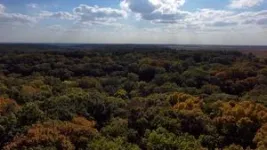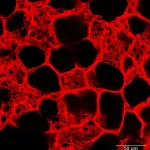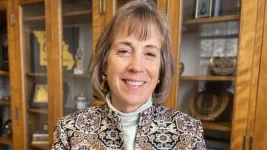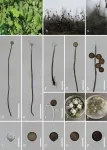(Press-News.org) WEST LAFAYETTE, Ind. — Extreme events wipe out entire forests, dramatically eliminating complex ecosystems as well as local communities.
Researchers have become quite familiar with such attention-grabbing events over the years. They know less, however, about the more common moderate-severity disturbances, such as relatively small fires, ice storms, and outbreaks of pests or pathogens.
“Since they’re more common, they’re probably playing a larger role in the ecosystem than we might have appreciated before,” said Brady Hardiman, associate professor of forestry and natural resources and environmental and ecological engineering in Purdue University’s College of Agriculture. “At any given time, a huge fraction of the forested landscape is undergoing or regrowing from a moderate-severity disturbance, which took out some of the trees but not all of them. The forest is not regrowing from scratch.”
A paper published in the Journal of Ecology by Purdue University researchers and their co-authors has identified how moderate-severity disturbances leave different patterns of change in the forest canopy structure. Hardiman and his colleagues based their findings on lidar (light detection and ranging) data collected at five sites of the National Science Foundation’s National Ecological Observatory Network in New Hampshire, Massachusetts, Virginia and Tennessee.
“The most interesting finding from this study is that the multitemporal lidar data can detect subtle signals of the disturbances,” said the paper’s lead author, Dennis Heejoon Choi, a Purdue postdoctoral scientist.
NEON began collecting data about 10 years ago. Repeat observations at specific forest sites of the type that NEON collects are still relatively rare, especially on a continental scale.
“NEON is a big sampling initiative,” said co-author Elizabeth LaRue, assistant professor of biological sciences at the University of Texas at El Paso. “It’s a big deal that now we have data to do something like this over time.”
Forest canopy structural dimensions include height, openness, density and complexity. Previous research by Hardiman and others has documented that structurally complex canopies absorb more light and that their complexity is linked to important ecosystem functions. These include nutrient cycling, providing shelter and nutrients to organisms, and biodiversity.
Comparing an old-growth forest to a Christmas tree farm offers a simple contrast in complexity, noted LaRue, a Purdue PhD alumna. Trees on a farm, planted in rows at about the same time, are all approximately the same age and height. An old-growth forest, meanwhile, shows far more variation with trees of different sizes, ages, species and shapes.
“You can measure things that might be equivalent to a block of cheese,” she said. “A block of Swiss cheese would be more complex than, say, a block of cheddar. Some of the metrics we use essentially measure how many holes you have in your block of forest.”
The researchers analyzed the differences between press and pulse disturbances, discrete events compared to those that occur over a longer period. The co-authors looked for patterns in changes to canopy structure following disturbances. They found that forests with canopy structures of more complexity seemed better able to withstand and recover from the disturbances.
“Canopy structure is something we can modify through management activities,” Hardiman said. “Managing forests to promote structural complexity could make them more resilient to a variety of disturbances in ways that allow our forests to continue growing following those disturbances.”
Wrangling the NEON data was a computationally intensive process that required the resources of Purdue’s Rosen Center for Advanced Computing. The process included accounting for the changes in lidar technology and differing sensor configurations used over the years. Newer lidar systems with stronger beams generate denser point clouds, the 3D data sets that represent the shape of the forest canopies.
“We tried to homogenize the point density equally year by year to make comparative metrics,” Choi said. The challenge was to balance the enhanced measurement capabilities of newer sensors with the need for consistency and comparability across time, he noted.
The work is part of the Institute for Digital Forestry’s effort to develop new tools and methods that will allow researchers to measure individual trees more often, in more detail, and to expand their measurements globally.
The institute brings together forest ecologists and foresters with computer scientists and engineers. Their combined expertise and perspectives provide a foundation for innovation by thinking about old questions in new ways and developing tools that allow them to ask new questions.
This work was funded by the National Science Foundation and the U.S. Department of Agriculture Forest Service. Also contributing to the Journal of Ecology paper were Purdue’s Songlin Fei and Bina Thapa; Jeff Atkins, USDA Forest Service; Jane Foster, University of Vermont; Jaclyn Hatala Matthes, Harvard Forest; and Robert Fahey, University of Connecticut.
Writer: Steve Koppes
END
Complex tree canopies help forests recover from moderate-severity disturbances
Less dramatic events now receiving more scientific attention
2024-02-06
ELSE PRESS RELEASES FROM THIS DATE:
Flu virus variants resistant to new antiviral drug candidate lose pathogenicity, study finds
2024-02-06
ATLANTA — Influenza A viruses with induced resistance to a new candidate antiviral drug were found to be impaired in cell culture and weakened in animals, according to a study by researchers in the Center for Translational Antiviral Research at Georgia State University.
In a study published in PLoS Pathogens, the authors explored the developmental potential of 4’-fluorouridine (4’-FlU), a clinical drug candidate, for influenza therapy. They resistance profiled the compound against influenza viruses and mapped possible routes of viral escape, addressing specifically ...
Microfluidic environments alter microbe behaviors, opening potential for engineering social evolution
2024-02-06
Microbes are social beings.
Much like humans, they communicate and cooperate with each other to solve problems bigger than themselves. In a microbial community, there will even be free riders, and others that police them.
So, what if researchers could influence their social evolution to promote certain behaviors? Doing so can be vital to solving many of today’s challenges such as combating infection and antibiotic resistance, developing microbial strategies for wastewater treatment or harvesting alternative energy sources.
A research group led by Dervis Can Vural, an associate professor in the Department of Physics and Astronomy at ...
Structural isomerization of individual molecules using a scanning tunneling microscope probe
2024-02-06
1. An international research team led by NIMS, the Osaka University Graduate School of Science and the Kanazawa University Nano Life Science Institute (WPI-NanoLSI) has succeeded for the first time in controlling the chirality of individual molecules through structural isomerization. The team also succeeded in synthesizing highly reactive diradicals with two unpaired electrons. These achievements were made using a scanning tunneling microscope probe at low temperatures.
2. It is usually quite challenging to control the chirality of individual molecular units and synthesize extremely reactive diradicals in organic chemistry, preventing ...
Moffitt study suggests improvements needed for patient-reported outcome data in genitourinary cancer clinical studies
2024-02-06
TAMPA, Fla. — Patient-reported outcomes are important indicators of how cancer drugs impact patients’ lives. By assessing the benefits and risks of drugs from a patient’s perspective, scientists and physicians can improve the development of patient-centered drugs and care. In a recent study published in eClinicalMedicine, part of The Lancet Discovery Science, Moffitt Cancer Center researchers demonstrate that there is a significant unmet need for improved analyses and reporting of patient-reported outcomes in genitourinary cancer clinical trials.
Health care professionals have realized that how a disease and its treatment ...
New EU-funded project "FOOD includes" aims to improve the inclusiveness and accessibility of adult education
2024-02-06
In December 2023, the new "FOOD includes" project funded by the European Commission started at the Center for Lifelong Learning at Johannes Gutenberg University Mainz (JGU). Over its 36-month term, the objective of "FOOD includes" is to increase take-up and improve the inclusiveness and accessibility of adult education. The project has been designed for adults with lower academic qualifications and migrants who are less likely to take advantage of continuing education and training opportunities. Therefore, the project focuses on activities revolving ...
New water-focused innovation engine aims to turn waste into wealth for Great Lakes region
2024-02-06
The waste in our water could soon generate new waves of clean energy development, job creation and economic growth across the Great Lakes thanks to a new regional innovation and economic development initiative launched by the U.S. National Science Foundation (NSF). The initiative will fund efforts to find new ways to recover clean water, nutrients and materials for clean energy technologies from wastewater — all while removing dangerous chemicals.
These efforts will be carried out by Great Lakes ReNEW, a collaboration of research institutions, universities, ...
Researchers breathe new life into lung repair
2024-02-06
In the human body, the lungs and their vasculature can be likened to a building with an intricate plumbing system. The lungs’ blood vessels are the pipes essential for transporting blood and nutrients for oxygen delivery and carbon dioxide removal. Much like how pipes can get rusty or clogged, disrupting normal water flow, damage from respiratory viruses, like SARS-CoV-2 or influenza, can interfere with this “plumbing system.”
In a recent study, researchers looked at the critical role of vascular ...
Promoting prosocial behavior in the classroom and beyond
2024-02-06
COLUMBIA, Mo. -- Christi Bergin has devoted 40 years of her life to helping teachers and their students. Throughout her career, she’s noticed two simultaneous trends in the field that seem to be connected: a rise in disruptive classroom behavior, and an exodus of teachers from the profession who leave due to stress and burnout.
To help combat these trends, Bergin, a professor emerita in the University of Missouri College of Education and Human Development, has focused her research on improving prosocial behavior — actions that show kindness, compassion, empathy and respect — in classrooms and communities.
Not ...
Perceptions of manhood and masculinities among disabled violently injured Black men in a hospital-based violence intervention program
2024-02-06
Black men with firearm-acquired disabilities face negative physical and psychological impacts on their manhood, independence and mobility, according to a Rutgers Health study.
The study, published in the American Journal of Men’s Health, explored the relationship between Black manhood/masculinities and firearm-acquired disabilities. Participants’ disabilities also impacted their perceptions of independence. Specifically, participants felt that they were a burden to their caretakers because of their reliance on them. This loss of independence ...
Two new freshwater fungi species in China enhance biodiversity knowledge
2024-02-06
Researchers have discovered two new freshwater hyphomycete (mould) species, Acrogenospora alangii and Conioscypha yunnanensis, in southwestern China.
This discovery, detailed in a study published in MycoKeys, marks the addition of these species to the Acrogenospora and Conioscypha genera, further enriching the diversity of freshwater fungi known in the region.
A research team consisting of Lu Li, Hong-Zhi Du and Ratchadawan Cheewangkoon from Chiang Mai University, Thailand, as well as Vinodhini Thiyagaraja and Rungtiwa Phookamsak from Kunming Institute of Botany, China, and Darbhe Jayarama Bhat from King Saud University, Saudi Arabia, employed comprehensive morphological ...
LAST 30 PRESS RELEASES:
Why nail-biting, procrastination and other self-sabotaging behaviors are rooted in survival instincts
Regional variations in mechanical properties of porcine leptomeninges
Artificial empathy in therapy and healthcare: advancements in interpersonal interaction technologies
Why some brains switch gears more efficiently than others
UVA’s Jundong Li wins ICDM’S 2025 Tao Li Award for data mining, machine learning
UVA’s low-power, high-performance computer power player Mircea Stan earns National Academy of Inventors fellowship
Not playing by the rules: USU researcher explores filamentous algae dynamics in rivers
Do our body clocks influence our risk of dementia?
Anthropologists offer new evidence of bipedalism in long-debated fossil discovery
Safer receipt paper from wood
Dosage-sensitive genes suggest no whole-genome duplications in ancestral angiosperm
First ancient human herpesvirus genomes document their deep history with humans
Why Some Bacteria Survive Antibiotics and How to Stop Them - New study reveals that bacteria can survive antibiotic treatment through two fundamentally different “shutdown modes”
UCLA study links scar healing to dangerous placenta condition
CHANGE-seq-BE finds off-target changes in the genome from base editors
The Journal of Nuclear Medicine Ahead-of-Print Tip Sheet: January 2, 2026
Delayed or absent first dose of measles, mumps, and rubella vaccination
Trends in US preterm birth rates by household income and race and ethnicity
Study identifies potential biomarker linked to progression and brain inflammation in multiple sclerosis
Many mothers in Norway do not show up for postnatal check-ups
Researchers want to find out why quick clay is so unstable
Superradiant spins show teamwork at the quantum scale
Cleveland Clinic Research links tumor bacteria to immunotherapy resistance in head and neck cancer
First Editorial of 2026: Resisting AI slop
Joint ground- and space-based observations reveal Saturn-mass rogue planet
Inheritable genetic variant offers protection against blood cancer risk and progression
Pigs settled Pacific islands alongside early human voyagers
A Coral reef’s daily pulse reshapes microbes in surrounding waters
EAST Tokamak experiments exceed plasma density limit, offering new approach to fusion ignition
Groundbreaking discovery reveals Africa’s oldest cremation pyre and complex ritual practices
[Press-News.org] Complex tree canopies help forests recover from moderate-severity disturbancesLess dramatic events now receiving more scientific attention







